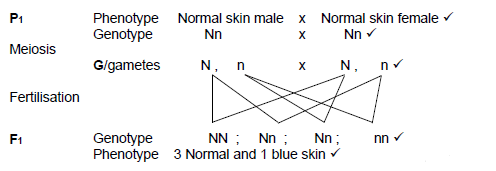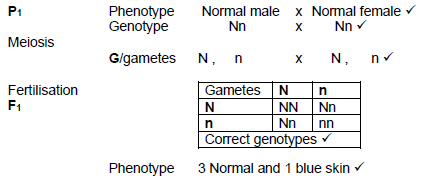Life Sciences Paper 2 Grade 12 Memorandum - NSC Past Papers And Memos September 2020 Preparatory Examinations
Share via Whatsapp Join our WhatsApp Group Join our Telegram GroupPRINCIPLES RELATED TO MARKING LIFE SCIENCES
- If more information than marks allocated is given
Stop marking when maximum marks is reached and put a wavy line and ‘max’ in the right-hand margin. - If, for example, three reasons are required and five are given
Mark the first three irrespective of whether all or some are correct/incorrect. - If whole process is given when only a part of it is required
Read all and credit the relevant part. - If comparisons are asked for but descriptions are given
Accept if the differences/similarities are clear. - If tabulation is required but paragraphs are given
Candidates will lose marks for not tabulating. - If diagrams are given with annotations when descriptions are required
Candidates will lose marks. - If flow charts are given instead of descriptions
Candidates will lose marks. - If sequence is muddled and links do not make sense
Where sequence and links are correct, credit. Where sequence and links are incorrect, do not credit. If sequence and links become correct again, resume credit. - Non-recognised abbreviations
Accept if first defined in answer. If not defined, do not credit the unrecognised abbreviation but credit the rest of the answer if correct. - Wrong numbering
If answer fits into the correct sequence of questions but the wrong number is given, it is acceptable. - If language used changes the intended meaning
Do not accept. - Spelling errors
If recognisable, accept the answer, provided it does not mean something else in Life Sciences or if it is out of context. - If common names are given in terminology
Accept, provided it was accepted at the national memo discussion meeting. - If only the letter is asked for but only the name is given (and vice versa)
Do not credit. - If units are not given in measurements
Candidates will lose marks. Marking guideline will allocate marks for units separately. - Be sensitive to the sense of an answer, which may be stated in a different way.
- Caption
All illustrations (diagrams, graphs, tables, etc.) must have a caption. - Code-switching of official languages (terms and concepts)
A single word or two that appear(s) in any official language other than the learners' assessment language used to the greatest extent in his/her answers should be credited if it is correct. A marker that is proficient in the relevant official language should be consulted. This is applicable to all official languages.
MEMORANDUM
SECTION A
QUESTION 1
1.1
1.1.1 A
1.1.2 C
1.1.3 D
1.1.4 D
1.1.5 A
1.1.6 B
1.1.7 C
1.1.8 B
1.1.9 B
1.1.10 A (10 x 2) (20)
1.2
1.2.1 alleles
1.2.2 double helix
1.2.3 interphase
1.2.4 population
1.2.5 Prophase I
1.2.6 phylogenetic tree / cladogram
1.2.7 biogeography
1.2.8 extinction (8)
1.3
1.3.1 A only
1.3.2 Both A and B
1.3.3 Both A and B (3 x 2) (6)
1.4
1.4.1 James Watson, Francis Crick (2)
1.4.2 Double helix (1)
1.4.3
- DNA codes for the formation of different proteins required in the body
- DNA is responsible for transmitting hereditary characteristics (2)
1.4.4
- Nucleus
- Mitochondrion (2)
1.4.5 Maurice Wilken (1)
(8)
1.5
1.5.1 Dihybrid cross (1)
1.5.2
- red (1)
- ffhh (2)
- red, tall (2)
- FH, Fh, fH, fh (1-3 correct, 4 correct ) (2)
(8)
TOTAL SECTION A: 50
QUESTION 2
2.1
2.1.1 Protein Synthesis (1)
2.1.2 cytoplasm /outside the nucleus (1)
2.1.3
- DNA (1)
- polypeptide chain /protein (1)
2.1.4 UGU (2)
2.1.5 ACG (1)
2.1.6 CCA (2)
2.1.7 Lysine (1)
2.1.8 If base sequence was UUU instead of AAA then:
- anticodon on tRNA would be AAA
- therefore amino acid would be Phenylanine
- instead of Lysine(3)
(13)
2.2
2.2.1 pedigree diagram (1)
2.2.2
- Blue skin female (1)
- Nn (1)
2.2.3 recessive allele (1)
2.2.4 Mabala and Maurice are both normal but their son Lunar has blue skin therefore, Mabala and Maurice are carriers of the disease
2.2.5
They have a 25% * chance of having a child with blue skin
P1 and F1
Meiosis and fertilisation
1 compulsory* + Any 6
OR

They have a 25% * chance of having a child with blue skin
P1 and F1
Meiosis and fertilisation
1 compulsory* + Any 6 (7)
2.3
2.3.1
- In the original population of Antarctic fish there was variation
- Some fish produced the antifreeze protein while others did not
- Those that did not produce antifreeze protein did not survive the icy, freezing waters
- Those that produced antifreeze survived the icy, freezing waters
- They reproduced and past on their characteristic to the next generation
- And eventually over time the number of antifreeze producing fish in the population increased (Any 5 x 1) (5)
2.3.2 Genetic Modification (1)
2.3.3
- Engineer cold resistant plants
- preserving food at very low temperatures (2)
2.3.4
- The gene coding for antifreeze protein production is isolated from a fish cell
- The gene is cut out using restriction enzymes
- A bacterial plasmid is removed and is cut open using restriction enzymes
- The antifreeze producing gene is inserted into the plasmid
- The genetically modified plasmid is returned to the bacterium
- The bacterium multiplies and all of the offspring have the gene for antifreeze protein production
- The bacteria produce anti-freeze (Any 5) (5)
2.3.5
- People who are allergic to fish proteins may not know that the plant contains it and will therefore be at risk.
- Vegans and vegetarians may not want to eat animal products and will be forced to if it is in plants
Mark first ONE only (Any 1) (1)
[40]
QUESTION 3
3.1
3.1.1 Co-dominance (1)
3.1.2 Both alleles are expressed in the offspring’s phenotype (2)
3.1.3
Genotype | RR | RB | BB |
Number of offspring | 5 | 10 | 5 |
OR
Genotype | Number of offspring |
RR | 5 |
RB | 10 |
BB | 5 |
Guidelines for assessing the table
| Correct table format (Separation of columns) | 1 |
| Column headings | 2 |
| Data entered | 1 : 1 to 2 sets correctly enetred 2 : All 3 data sets correctly entered |
(5)
3.1.4 Both parents have a Phenotype – Red and Genotype – RR (2)
3.2
3.2.1
- Increase in Muscle Protein Synthesis (1)
- Amount of protein (1)
3.2.2
- Get permission from participants / doctor
- Determine how to measure MPR / how data will be collected
- Train data collectors on how to measure MPR
- Determine sample size
Mark first TWO only (Any 2) (2)
3.2.3
- It had a large sample size /100 participants
- It obtained similar results to two other investigations (2)
3.2.4 Percentage increase
- = 1 x 100 = 9,09% (2)
11
3.2.5
- There is very little increase in MPR from 20 g to 40 g
- therefore you will gain very little for double the amount of protein (2) (10)
3.3
3.3.1 Stem cell are undifferentiated cells that has the potential to form any tissue of organ (2)
3.3.2
- Cord blood, umbilical cord blood
- Bone marrow
- Blood, peripheral blood stem cells
- Menstrual blood OR Adult stem cells
- Skin
- Teeth
- Placental tissue
(Any 2) (2)
3.3.3 Spinal cord injuries /neurodegenerative diseases (Parkinson’s disease / Alzheimer’s disease / Amyotrophic lateral sclerosis) (Any 1) (1)
3.4 3.4.1 There are 3 alleles / more than two for blood groups A, B and O (2)
3.4.2 ![]() (2)
(2)
3.4.3 If the man was IBi and the woman was IAi then they would both pass the recessive allele/I to their child. (3)
3.4
3.5.1
- All elephants had short trunks / noses
- They frequently stretched their trunk / nose to reach for leaves in the trees
- As a result, their trunks became longer
- The characteristic for long trunks acquired in this way was then passed on to the next generation
- Eventually all elephants had long trunks (5)
3.5.2
- Organisms evolved, not because they wanted to evolve but because changes took place randomly, in response to the environment
- There is very little evidence to support Lamarck’s idea that changes brought about by adaptation to the environment are inherited from parent to offspring (2)
3.5.3 Characteristics are past from parents to offspring (1)
[40]
TOTAL SECTION B: 80
SECTION C
QUESTION 4
Composition of karyotype
- There are 23 pairs /46 chromosomes in
- human somatic cells /body cells
- which are arranged into homologous pairs
- Each somatic cell has 22 pairs/44 autosomes and
- a pair/2 gonosomes /sex chromosomes/ X and Y chromosome
- Autosomes are arranged in pairs from largest to smallest in a karyotype
- Males have XY chromosomes
- Females have XX chromosomes
- The X chromosome is larger than the Y chromosome (Any 6) (6)
Importance of meiosis
- Production of haploid gametes
- Halving effect overcomes the doubling effect of fertilization
- Thus, maintaining a constant chromosome number
- Introduces variation (Any 3) (3)
Effect of non-disjunction in humans
- Humans may be affected by aneuploidy
- Aneuploidy/Non-disjunction occurs when chromosomes do not separate
- during anaphase
- During anaphase 1 a single pair of homologous chromosomes do not separate
- Or during anaphase 2 chromatids do not separate
- One gamete will receive two copies of the same chromosome
- While the other gamete will receive none
- If fertilisation occurs between the abnormal gamete and a normal gamete the resulting cell / zygote will have one less chromosome / the zygote will be monosomic
- Or the zygote may have an extra chromosome / the zygote will be trisomic
- Down Syndrome / Trisomy 21 is an example of aneuploidy in humans
(Any 8) (8)
ASSESSING THE PRESENTATION OF THE ESSAY
Criterion | Relevance (R) | Logical sequence (L) | Comprehensive (C) |
Generally | All information provided is relevant to the question | Ideas are arranged in a logical/cause-effect sequence | All aspects required by the essay have been sufficiently addressed |
In this essay in Q4 | Only information relevant to the description of:
There is no irrelevant information | All the information regarding the
Is given in a logical manner | At least:
|
Mark | 1 | 1 | 1 |
Content 17
Synthesis 3
TOTAL SECTION C: 20
GRAND TOTAL: 150